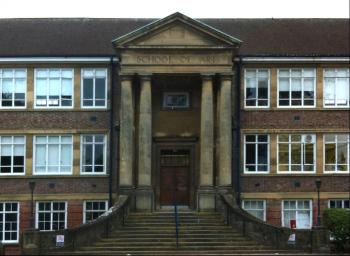Guildford School of Art
The Guildford Institute was formed in June 1843 by the merging of the Mechanics' Institute, which was founded in 1834 and the Literary and Scientific Institution, founded in 1835. In 1850, the Institute offered to provide exhibits for the Great Exhibition of 1851, but the Royal Commission patronisingly declined the offer, saying it was unlikely they could provide anything of interest. The Guildford Working Men's Institution, a breakaway body was formed in 1856 and it was as part of this latter body, rather than the Institute, that a Drawing Class was inaugurated in 1857 under the auspices of artist Charles Claude Pyne (1802-1878) who was the son of eminent artist, writer and illustrator William Henry Pyne, (1769-1843) one of the founder members of the Society of Painters in Water Colours later to be known as the Royal Watercolour Society. In 1892, the Guildford Institute and the Guildford Working Men's Institution were merged under the title of the Guildford and Working Men's Institution.
Purpose-built accommodation for the Technical Institute was provided, and a new building was opened in March 1910 by Mary Seton Watts a Scottish designer and potter and the widow of the famous Victorian painter and sculptor, George Frederic Watts of the Symbolist movement. It was built to accommodate both science and art. It was paid for jointly by County and Borough Councils, and it had classrooms, laboratories and workshops for up to 700 pupils. The Head Master of the Art Department remained Victor Burnand, assisted by Herbert Arthur Humphrey Patrick. Maurice Wheatley became principal in the 1930's but was called up for war service.
Throughout World War II, the school had grown steadily, and Mildred Lockley became the new acting Principal. Jacob Drew was in charge of the work of the glass department, and at the cessation of hostilities, Maurice Wheatley returned as the Principal, holding the post until 1950. By now the organisation was known as the Guildford School of Art and Crafts with courses that included Drawing, Design, Photography, Printing and Allied Subjects, Sculpture, Architecture, Painting and Decorating and Women's Crafts such as Dressmaking, Millinery and Fabric Printing. The Photography department was a major centre of photographic excellence under its Head, Ifor Elrwyn Thomas (1912-1961) and his wife Joy, who also lectured. It soon developed an international reputation. Student protests over the quality of education took place in the late 1960's. The protest resulted in the longest student sit-in in British history, lasting from which lasted from June 5th to July 29th. There was an eventual recommendation for the closure of the School, which eventually merged with the Farnham School of Art in 1969 to become part of the West Surrey College of Art and Design. Other staff and alumni included Trevor Tennant, Harry Phillips, Elisabeth Frink, Dudley Holland, Alan Coleman, and John Kashdan, to name but a few.
Get Unlimited Access from just £5


